Then at first, let’s learn the meaning or what is e-commerce and its business? It is familiar as electronic commerce that helps firm dealings driven via online. Or, it’s a company model that permits all to buy and sell things and services online.
Its Top Benchmark:
- It’s a platform to buy and sell items and services online.
- It easily runs with computers, smart phones, tablets, and other modern devices.
- You can buy almost anything with it.
- It operates four market segments, B2B, B2C, C2C, and C2B.
In a word, it’s a software package for buying and selling plus the transfer of data and money to end the sales. Also, eCommerce is approved by electronic businesses.
What are the Benefits of Using e_commerce Business?
Expanding your e-commerce business models through an online marketplace can be a game-changer. Offering numerous benefits and advantages to help you grow. By setting up an online store, you can extend your customer reach beyond your local or regional area and benefit from lower overhead costs compared to traditional brick-and-mortar stores. Providing a convenient and user-friendly online shopping experience can also boost sales and revenue. Here are some key points to consider when deciding whether to take your business online:
1) Advantages of Faster Shopping Process
The first and foremost advantage of eCommerce is the speedy shopping process. With just a few clicks, buyers can easily browse through a wide range of products and buy what they like instantly. They can access products that may not be available in their local area or difficult to find otherwise.
This is why e-commerce has become a savior for many buyers. Online shoppers can easily search for a product, get a fast response, and purchase it promptly, saving them time and effort.
The benefits of eCommerce also include a vast selection of products, quick order delivery, and an overall faster shopping experience. From searching for a product to viewing its description and adding it to the cart, every step is efficient and convenient. This leaves shoppers satisfied because they have the product they want without having to leave their home.
2) Revolutionizing Inventory Management
Ecommerce has revolutionized inventory management. Which is crucial for the success of clothing and fashion stores as well as electronics and gadget stores. A well-stocked and organized inventory management system is essential for making informed decisions about restocking, pricing, delivery and storage. Accurate and up-to-date product information is key to effective inventory management. Including information on product availability, location, and condition.
Efficient processes for receiving and processing new stock are also essential for these businesses. This includes tracking and labeling products, as well as quickly and accurately updating inventory records. Effective inventory management can lead to increased sales, improved customer satisfaction, and long-term business success.
Also, a well-organized product chart, similar to an inventory table, can contribute significantly to the success of these businesses. By creating a streamlined and visually appealing display of products. Customers can easily find what they’re looking for and make purchases more efficiently. Overall, an effective store and product table are essential for well-organized inventory management in wholesale, dropshipping, and retail businesses.
3) Price Reduction
Price reduction is a common strategy in eCommerce, where businesses conduct transactions online. Electronic commerce, refers to buying and selling goods and services over the internet. This model is often grouped with e-business. Which includes various online activities like marketing and supply chain management. Can be a powerful way to attract customers and increase sales, but businesses must balance the impact on profits and strategy. eCommerce businesses can also use upselling and cross-selling to improve the bottom line. By analyzing market trends and customer behavior, businesses can make informed decisions about pricing and sales strategies to achieve their goals.
4) Affordable Ads and Marketing
There are many affordable and efficient plans available for marketing online. with eCommerce marketplaces offering visual systems that allow sellers to showcase their products. Top brand sellers can use advertising tools to merge infographics, videos, and high-resolution photos. Without needing to spend significant amounts on promotion.
DIY features are available for creating A+ content, coupons, customized deals, and sponsored ads. with some company offering customer insight tools for analyzing customers. Also provide a centralized page for managing orders, including pending, returns, sent, unshipped, and canceled.
In eCommerce, social media platforms provide a cost-effective way to promote products and increase brand awareness, while search engine optimization can improve visibility without the need for paid advertising. Email marketing can encourage customer loyalty and repeat purchases. By utilizing these strategies, businesses can save money on advertising and marketing and effectively promote their products.
5) Customers Flexibility
Electronic commerce or eCommerce provides flexibility for customers to purchase products or services at any time, from any location. With 24×7 availability, sellers can offer their goods or services to customers at their convenience. Additionally, customers can leave feedback on their purchases, which can result in increased trust and identification of the best-selling products. eCommerce is a key component of eBusiness operations.
6) No Limitations For Reaching Customer
Unlike physical stores that are limited by distance and logistics, eCommerce sellers can reach an unlimited number of customers online. There are no boundaries to how far they can extend their business and attract new clients. Moreover, online sellers can reduce logistics and delivery costs, making it easier to expand their reach and increase profits. This is just one of the many advantages of electronic commerce or eBusiness.
7) Price and Product Comparison
Physical stores face limitations when it comes to collecting details about their products. However, eCommerce businesses have the advantage of using tools and tactics to compare their products, giving them a better understanding of pricing and other important details. With eCommerce, sellers can easily compare their products with competitors and offer the best possible prices to customers. This is just one of the many benefits of eCommerce, which is a subset of electronic commerce or eBusiness.
8) Faster response
One of the benefits of eCommerce is faster response time for customers. In traditional physical stores, it can be difficult to gather detailed information about products or inventory. However, with eCommerce, online sellers can use various tools and tactics to quickly provide customers with information about products, prices, and more. This is just one advantage of eCommerce, which is a type of e-commerce.
9) Many Payment Methods of e Commerce Business
One of the major advantages of an e-commerce platform is the availability of multiple payment options. You can offer various payment modes such as cash on delivery, credit or debit card payments in EMIs, and even credit facilities.
Moreover, you can use a cart recovery system to remind customers who have reached the checkout page but haven’t completed their purchase. This can be done through WhatsApp, phone, SMS, or email, which increases the chances of closing a potential sale.
Customers can choose any payment mode that suits them, making it more convenient for them to place an order. This also reduces the anxiety for sellers of losing potential sales.
Apart from the above benefits, there are many other advantages of e-commerce for both sellers and buyers. These include:
- Streamlined customer experience
- Reduced administration and labor costs
- Improved order tracking and customer service
- Mobile adaptability
- Targeted content delivery
- Inventory management
- Excellent customer service
- Easy administration
- User-friendly for both users and customers
- Less downtime
- More secure.
Types of an e-commerce business
There have been significant changes in the way people shop in the last decade. Shopping has become much more convenient due to the advent of e-commerce. If you’re considering starting an e-commerce business, you should know that there are at least four traditional types, each with its own set of benefits and challenges. These types include Business to Business (B2B), Business to Consumer (B2C), Consumer to Business (C2B), and Consumer to Consumer (C2C). Additionally, there are new innovative types to consider, such as Business to Administration (B2A), Consumer to Administration (C2A), and Business to Government (B2G). In this article, we’ll explore these different types of e-commerce businesses and provide examples of websites that use them.
Business to Business (B2B)
B2B, or Business to Business, is a business model in which goods or services are sold to other companies. While the end-user may occasionally be the client, more often the shopper resells to the consumer.
In the modern era, B2B companies have created online storefronts with features such as catalogs and order sheets.
As of 2020, almost half of B2B buyers are millennials, and this number has nearly doubled since 2012.
Now let’s take a look at some examples of companies that use B2B eCommerce.
- ResMed: This global healthcare company has over 9 million cloud-based devices in use, and it also provides remote patient monitoring services.
- Asana: A platform that helps businesses by bringing all their services into one integrated space. It is used by over 100,000 paying companies and millions of teams worldwide.
- Evernote: With over 220 million users worldwide, Evernote is used in more than 20 languages every day.
- Hootsuite: This platform helps companies prepare for the future and leverage the power of social media. It is used in over 200 countries by more than 200,000 paying clients to tell their brand stories.
Business to Consumer (B2C)
B2C is the most popular and regular e_commerce business model that sells to its end-user. And you’ll have plenty of special directions under this system.
What you’ll want to buy as a consumer online? Are you think of household supplies, wardrobes, or entertainment? Each thing you’ll find as a part of B2C methods.
In a word, to decide to buy, B2C is easier than B2B. And especially for that types of goods which have a lower cost.
So, let’s check the companies that are using B2C eCommerce.
- Amazon: is a popular and well-known e-commerce company that operates on a B2C business model. It focuses on enhancing the customer experience by using modern technology to help customers search, discover, and purchase a wide variety of products online.
- BrandAlley: offers a wide selection of the latest season’s stock at discounted prices of up to 90% off the RRP. It caters to various destinations with exclusive deals on designer brands. Additionally, customers can browse their curated collection of designer treasures for an instant luxury shopping experience.
- Condé Nast: is a trusted home for some of the world’s most iconic brands, including The New Yorker, Vanity Fair, AD, GQ, Wired, and more. With a mission to entertain, surprise, and empower its audience, it provides unique access to exceptional content and leads the way in media and publishing.
- Nut: is a premier provider of premium nuts and dried fruits worldwide. They use 100% post-consumer recycled cardboard boxes and biodegradable packing peanuts to reduce their environmental impact. In addition, they offer over 250 organic products.
Consumer to Business (C2B):
The Consumer to Business (C2B) model allows individuals to sell their products or services to companies. This model allows customers to post what they want to achieve and allows businesses to bid for the option, making it a competitive pricing system. Firms can also use this model to directly meet their goals and merge with social media holders to market their goods.
Here are some companies that are using this platform:
- Google Search: Its mission is to take and organize the world’s information to deliver global access and value. It allows users to search for sports, families, hobbies, movies, celebrities, and more.
- Adobe Stock (formerly Fotolia): Offers high-quality images, videos, graphics, and more from the world’s great creative community with Visual Search presented by Adobe Sensei.
- BiQ: The world’s first SEO suite powered by Artificial Intelligence (AI), providing high rankings and increased traffic. It covers all aspects needed to boost your website in reality.
Consumer to Consumer (C2C):
C2C (Consumer-to-Consumer) is a type of online marketplace where consumers can buy and sell products and services directly with each other. The business model operates by charging listing or transaction fees to the users.
Craigslist and eBay are some of the pioneers in this model of eCommerce.
While C2C businesses can benefit from self-driven growth by motivated customers and vendors, they face challenges in maintaining quality control and technology.
Let’s take a look at some businesses using this platform:
- Capital: A CySEC, FCA, and ASIC licensed fintech organization, focused on making the world of finance more accessible, engaging, and valuable. Their mission is to provide the best trading experience in the world.
- Vantage: A regulated Forex broker providing traders access to the world’s Forex market through the best FX liquidity providers. They offer high-speed trade execution, RAW ECN spreads, and interbank grade services.
Business to Administration (B2A):
B2A, also known as e-commerce business to government, involves all the activities between businesses and public administrations or government agencies. This field is particularly focused on mass services, especially in areas such as social safety, employment, and legal documents.
Although government contracts can involve a lot of paperwork, time, and verification, providing products and services in the public sector can bring many benefits. In most cases, government contracts are larger and more long-lasting than similar private sector work. A company with a successful track record in government contracting can often secure new contracts more quickly.
One company that uses this model is:
- Accela: For the past 20 years, Accela has been at the forefront of government software design and delivery. Their mission is to enhance skills, expand citizen participation, and promote the growth of thriving communities.
Consumer to Administration (C2A):
C2A is a type of online business that facilitates transactions between individual consumers and government agencies or offices. While state authorities may also purchase items or services from residents, citizens commonly use C2A services.
This model has emerged in the past decade and incorporates various applications, such as e-democracy, e-voting, e-health, and public services information.
By using these services, consumers can directly communicate with their local officials, provide feedback, request information, and post their opinions.
C2A provides a direct connection between the local government and citizens. Examples include websites of the local council and civic facilities that inform the public about health, education, community events, road closures, taxes, social safety, and more.
Business to Government (B2G)
B2G refers to the business-to-government model, where private sector companies offer their goods and services to government agencies. The government typically requests these services through Request for Proposals (RFPs). This model can range from small businesses providing IT support to local government to larger companies like Boeing, which produces fighter jets, aircraft, helicopters, missile defense systems, and more for the Department of Defense.
Here are some examples of companies that use this model:
- Senseware: Senseware promotes creativity and diversity through its people and actions. It also provides excellent products and customer service to its clients at every possible step.
- Mark43: Mark43’s goal is to empower people and their authorities with new technology to enhance their security and quality of life.
Now that we’ve covered what eCommerce is, its types, benefits, and how it works, let’s move on to learning about the best eCommerce platforms available.
BigCommerce
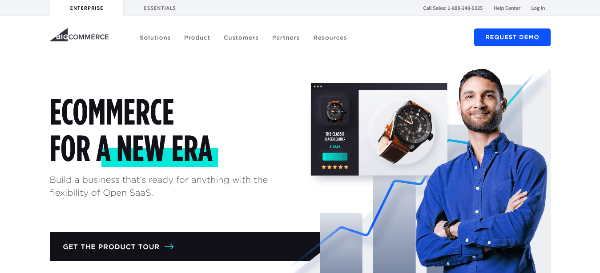
BigCommerce is an open SaaS application that provides flexibility to create a business selling almost anything. With its features, you can optimize your sales, advertise, list, sell, and fulfill products across 100+ channels such as Google, Amazon, Facebook, eBay, Snap, TikTok, and more. Additionally, you can design your store with freedom, operate with ease, and outdo your competitors. You can sell a variety of items like accessories, electronics, books, music, software, optical products, gift cards, and much more on BigCommerce.
Shopify

Shopify is an eCommerce platform that is trusted by more than a million of the world’s most successful and well-known brands. It offers a seamless process for selling, shipping, and accepting payments from customers anywhere. With its powerful tools, you can easily find and attract customers, boost sales, and efficiently manage your daily operations.
Shopify can help you create the ultimate online shop for a wide range of industries, such as cargo, yoga, wedding, videography, towing, solar energy, skincare, resort, logistics, and many more. Its flexibility and customizable features make it a great choice for any type of eCommerce business.
Wix eCommerce
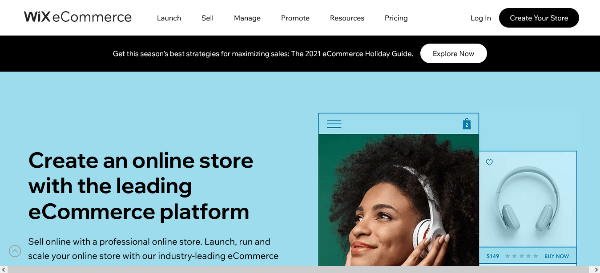
Are you looking to create a professional online store or scale your existing one with top-notch site builders and features? Wix eCommerce is the perfect solution for you. With over 500+ free templates to choose from, you can customize your site to suit your needs and launch your store in no time.
Shift4Shop

Shift4Shop is a powerful solution that can help you quickly create and expand your online business. One of its key advantages is that it is entirely free to use and allows you to easily migrate your existing website. With Shift4Shop, you can take advantage of a range of features, including a website builder, SEO optimization, a shopping cart, mobile-friendly layouts, real-time shipping, and credit card processing. This can help you streamline your operations and provide a seamless shopping experience for your customers.
WooCommerce

WooCommerce is an open-source, customizable eCommerce platform built on WordPress. It can easily be added to any WordPress site as a plugin, allowing you to create a professional online store quickly and easily. It offers secure payment processing, flexible shipping options, and many other features for free. With thousands of free and paid themes and plugins available, it’s perfect for businesses of all types, whether you’re running a booking site, rental platform, directory, or a multi-vendor portal.
Volusion
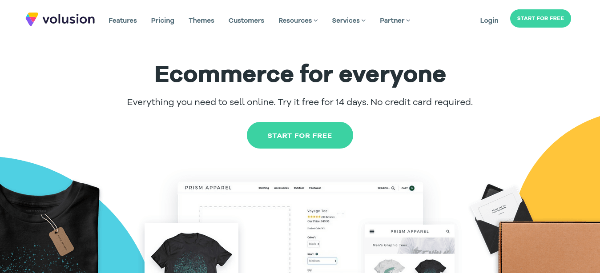
Volusion provides a comprehensive platform for online selling, which is trusted by over 180,000 successful entrepreneurs. With its advanced inventory management, payment processing, search engine optimization, and various product options, it enables you to create a successful online store. Moreover, you can try the platform for 14 days without submitting any credit card information.
Yo-Kart
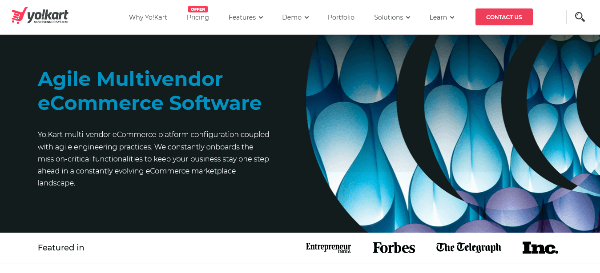
Yo-Kart offers an efficient and customizable multi-vendor software suitable for startups and large businesses alike. It allows you to quickly enter new markets, reduce your time to market, gain a competitive advantage, and accelerate the growth of your business. With Yo-Kart, you can easily implement features like item comparison, auctions, affiliate programs, and bidding systems.
Sellfy

Sellfy is a user-friendly platform for those who want to sell products online easily and quickly. You can set up your store in just a few clicks by signing up, adding your items, and customizing your shop. This hassle-free process will save you time and effort, allowing you to focus on your business.
Squarespace

Squarespace is an all-in-one platform that allows you to create an online store to sell anything. Whether you are just starting out or a well-known brand. With Squarespace, you can showcase your products at their best and customize your store to fit your brand.
OpenCart
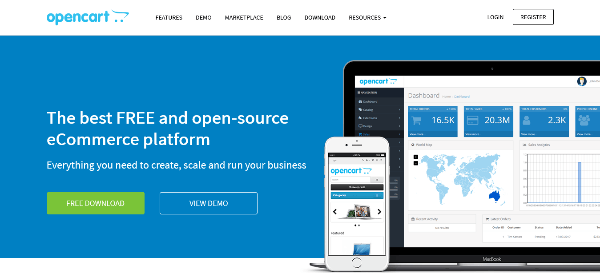
OpenCart is a powerful and free open-source platform that provides you with all the essential tools to create, expand, and manage your online business. With its built-in SEO features, you can optimize your store for search engines and attract more visitors. It also offers robust features such as product management, order processing, tax management, coupon creation, and much more. Additionally, you can benefit from reliable commercial support or free community support. These eCommerce platforms are some of the most widely used and efficient, and you can choose any of them to suit your business needs.
Some Helpful eCommerce Modules to Better Management
Let’s discuss some useful eCommerce modules that can help you better manage your online store. To begin with, we can look at the best payment gateway modules that can elevate your website to new heights.
Best Payment Gateways
Payment gateways are crucial for any e-commerce business, as they automate payment processing between the buyer and merchant. They allow merchants to accept various forms of electronic payments, including credit cards, and offer features like subscription management and recurring payments.
Here are some of the best payment gateway models:
- PayPal: With over 20 years of experience, PayPal is a popular and trusted payment gateway used in over 200 markets worldwide, supporting over 100 different currencies.
- Stripe: Founded in 2009, Stripe provides payment processing software and APIs for e-commerce websites and mobile apps. It operates in both San Francisco and Dublin.
- Authorize.Net: Based in the United States, Authorize.Net allows merchants to accept credit card and electronic check payments through their website’s IP connection.
- 2Checkout: Established in 2006, 2Checkout is an electronic payment system that enables merchants to accept online credit card payments from customers worldwide.
- WePay: Founded in Boston in 2008, WePay is a US-based payment service provider that offers secure payment solutions through its APIs.
- Skrill: Skrill is a digital wallet provider that offers fast and secure payments in over 120 countries and 40 currencies. It is popular for a wide range of activities, from online shopping and gaming to trading and betting.
Aside from payment gateways, catalog management software is also crucial for e-commerce businesses.
Catalog Management Software
There are several options available online for Catalog Management Software, including ROI Hunter, Plytix PIM, Catsy, and SellerCloud, among others. These software programs help in quickly finding, updating, and managing buyers’ products, thus improving their overall shopping experience.
Now, let’s take a look at some of the best dropshipping software available in the market.
Best Drop Shipping Software
This software helps eCommerce businesses to analyze their sales and customer data to make informed decisions. It provides insights into customer behavior, sales trends, and product performance. It helps in identifying areas for improvement and optimizing marketing strategies.
There are many types of eCommerce analytics software available, such as Google Analytics, Adobe Analytics, Mixpanel, and Kissmetrics. These tools offer various features, including data visualization, funnel analysis, customer segmentation, and A/B testing.
Using eCommerce analytics software, businesses can track their website traffic, conversion rates, and revenue. They can also monitor the effectiveness of their marketing campaigns and make data-driven decisions to improve their performance.
In conclusion, eCommerce analytics software is essential for any eCommerce business looking to grow and succeed in today’s competitive market.
e-Commerce Business Analytics Software
If you want to know what is eCommerce business analytics do? The short answer is to find out exactly which products are selling the most, who are their customers, conversion rate, and website’s which aspects draw the most attention from the store.
Almost every large or small business owner is concerned about the total view of their business and its execution at different levels. And they get all info by uniting big data analytics with a web analytics tool.
You’ll get lots of software to use for analytics reports online. But Mixpanel, Edrone, OWOX BI, Woopra are the few names of its best and topmost Analytics Software.
Now it’s time to talk about a vital subject called Fraud Protection Software. So, making more delay, let’s jump on this topic.
e-Commerce Fraud Protection Software
In the world of eCommerce, fraud is a significant concern for businesses. Fraud protection software aims to prevent fraudulent activities and transactions, such as stolen credit card information or fake orders.
Fraud protection software uses various techniques to identify and prevent fraudulent activities, such as machine learning algorithms, rule-based systems, and behavioral analysis. These tools help eCommerce businesses to reduce their risk and prevent financial losses.
There are many fraud protection software options available online, such as Signifyd, Sift Science, Riskified, and Kount. These software solutions offer real-time protection and monitoring to detect and prevent fraudulent transactions.
Now that we’ve covered fraud protection, let’s move on to another important topic: payment gateways.
Summary
I hope this article helped you understand what e-commerce business is and how it functions with its various components. As e-commerce is a constantly evolving field, modifications may be necessary to add or remove definitions. Please don’t hesitate to leave your thoughts in the comments section below.
If you found this article helpful, kindly share it with your friends and family.

